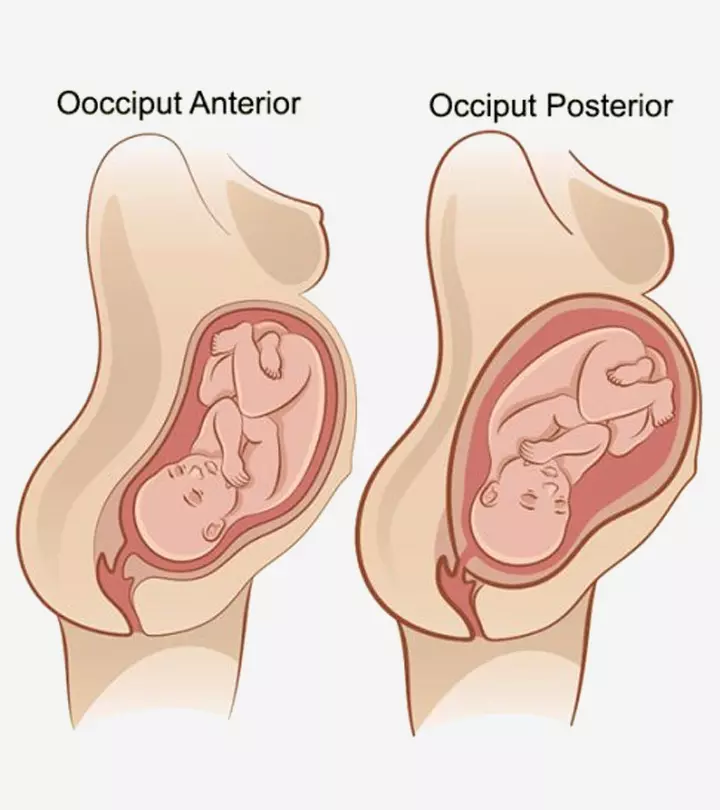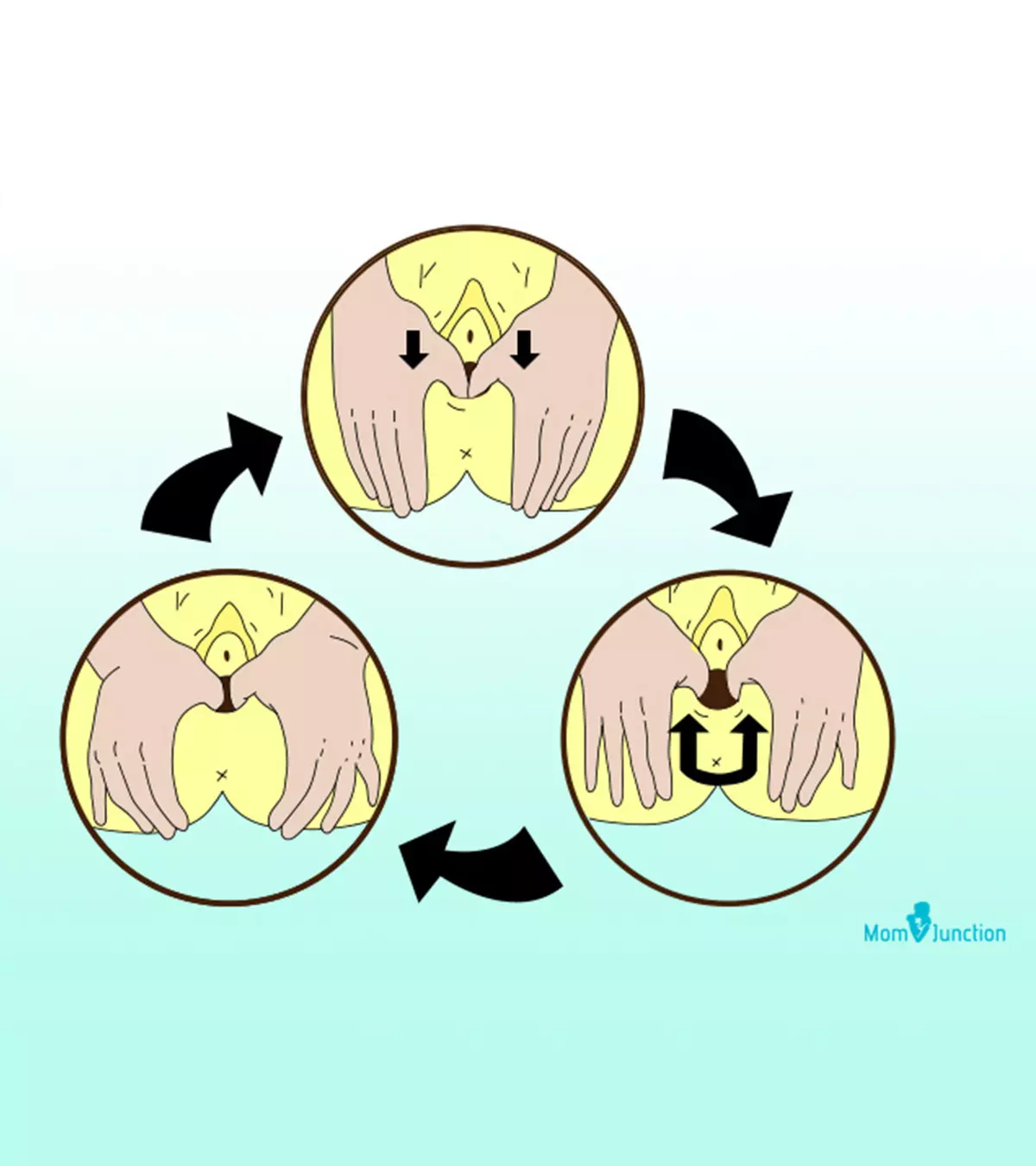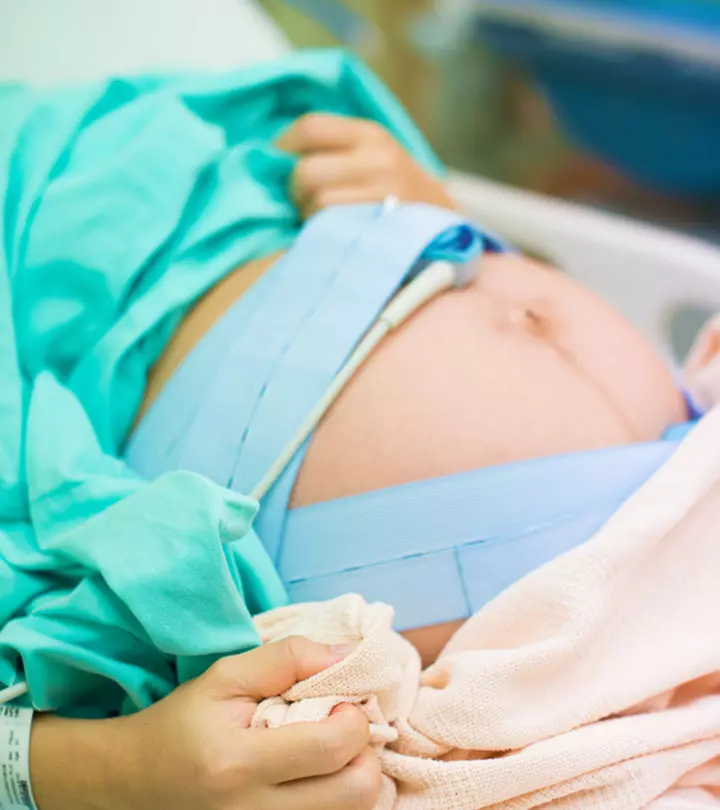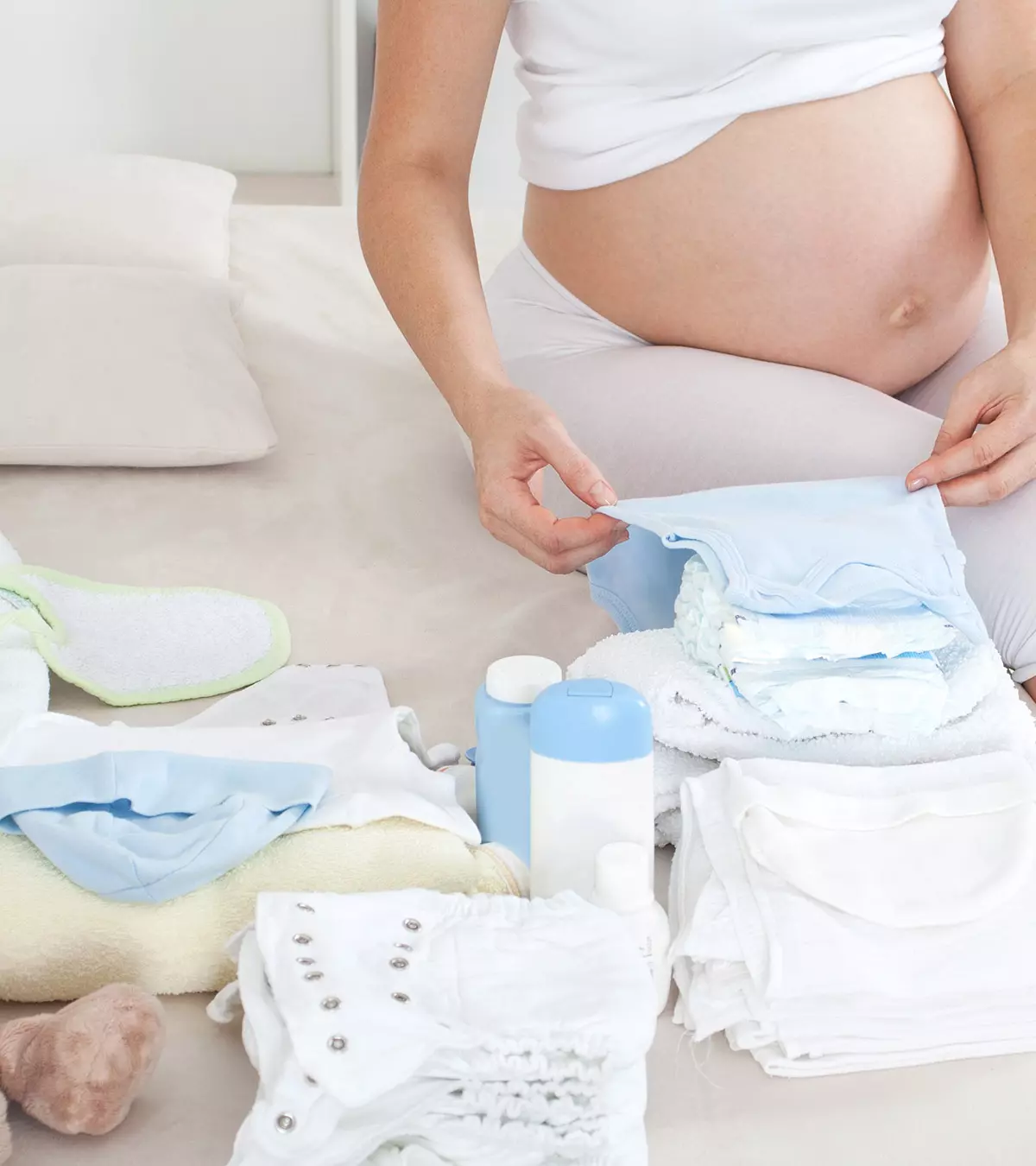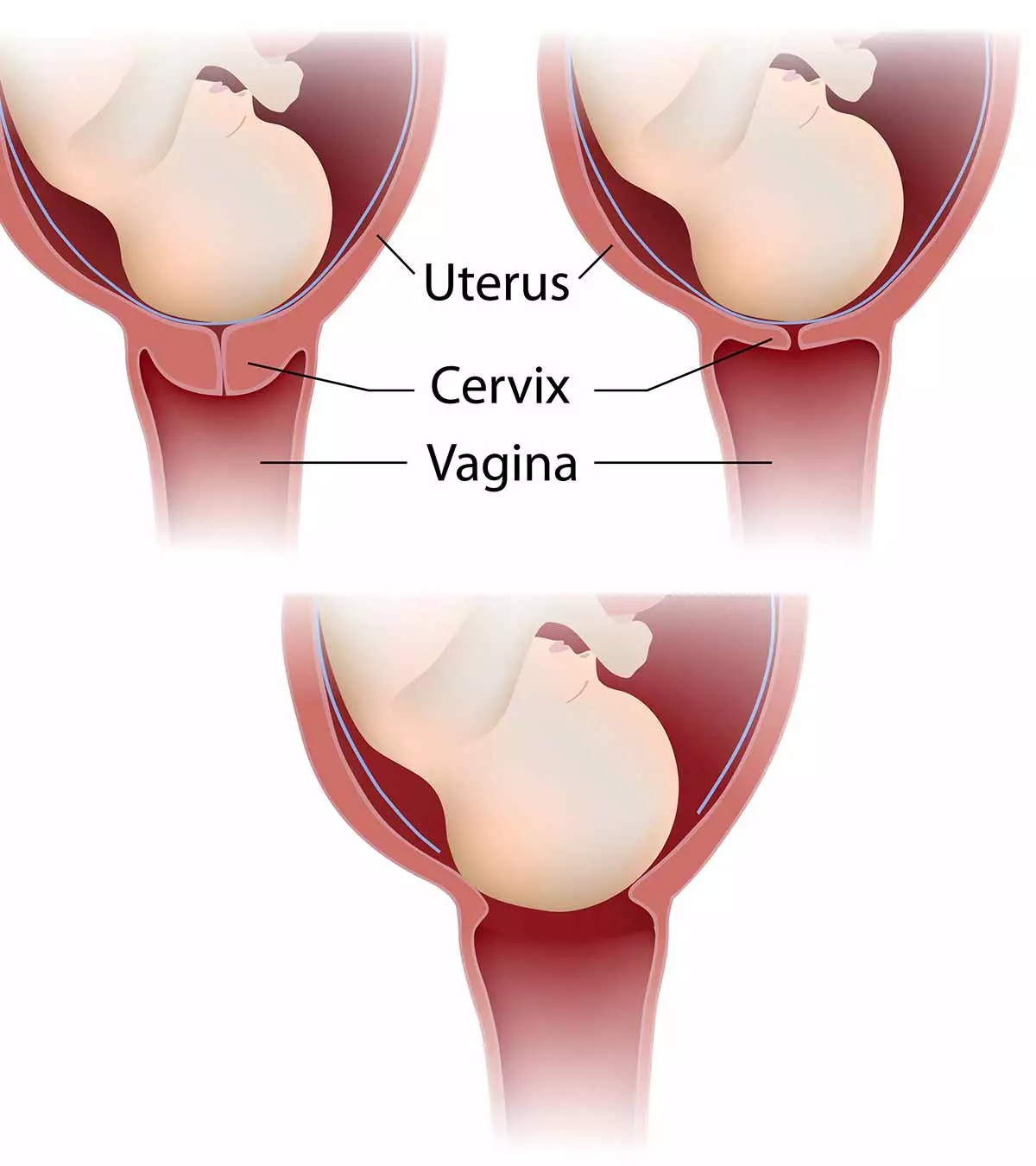
Image: ShutterStock
Dilation and effacement of the cervix during birth allow vaginal delivery.
After the initial contractions, the cervix gradually begins to dilate and soften. Your obstetrician or midwives may observe these changes to ensure that your body is preparing for natural vaginal birth. This process is physiological, and there is no need to worry about safety.
Most women, especially for the first time, have concerns and queries about labor and delivery. However, it is normal, and knowing what happens can help reduce anxiety and stress during delivery. Read on to know more about cervical changes during each stage of labor and birth and ways to relax during labor.
Key Pointers
- The cervix remains closed during pregnancy to protect the fetus’ growth and development.
- In response to intrauterine pressure and uterine contractions, the cervix must stretch during labor.
- The cervix can dilate up to 10 cm to allow safe passage for the baby’s head.
- Complications with the cervix, such as cervical stenosis and insufficiency, may occur for some women.
- To ensure a smooth labor, it’s crucial to relax, listen to your body, meditate, educate yourself on pain relief options, change positions, and breathe.
What Happens To The Cervix During Birth?

Image: Shutterstock
This might be the foremost question pregnant mothers ask their doctors. Let us help you with this.
Labor is a physically and mentally challenging process. During this process, your body goes through a lot of stress while it gets ready. The cervix, which is located between your vagina and uterus, also prepares itself for labor during the process. Until labor, the cervix stays blocked by a mucus plug. It may come out once labor starts and is called your “show” (1).
8 Cervix Changes During Labor
Through your pregnancy and during labor, your cervix goes through the following different changes:
1. The cervix is designed to protect the development of the fetus. It remains closed and provides support to the growing fetus and the uterus in an expectant mother’s body.
2. At first, the cervix has to move from the posterior position into the anterior position so that it’s pointing forward (2).
3. During labor the cervix needs to flex to intrauterine pressure and contractions of the uterus.
4. It also has to achieve effacement, which is thinning of the wall (3).
5. As the pregnancy reaches its end, the cervix prepares itself for childbirth. This is known as “cervical ripening.” (4)
6. It starts to change in color and also starts to soften. These changes make the cervix stretch and thin. This is to enable it to deal with labor contractions.
7. The cervix goes from fully closed to 10 centimeters dilation during labor to allow the fetal head to pass through it (5).
8. The cervix dilation during labor is as follows (5):

Image: Shutterstock
- Latent Phase: 0-3 centimeters
- Active Labor: 4 cm and above
- Fully Dilated: 10 centimeters; shortly after this stage the baby is delivered.
 Did you know?
Did you know?What Are The Complications With The Cervix During Labor?
At times, there can be some complications or problems with the cervix, such as mentioned below (6) (7):
- The cervix is designed to shorten and widen during pre-labor contractions. If it widens without contraction it’s called incompetent, and this could lead to premature delivery.
- If this happens, a cervical cerclage is done, where stitches are placed on the cervix to hold it close.
- Cervical insufficiency is rare and is experienced by around one percent of women who undergo preterm labor (8).
- In rare cases, a woman may have cervical stenosis, that is the narrowing of the canal of the cervix. This could be due to an earlier infection, radiation exposure, surgery, or just a genetic anomaly.
Discussing her childbirth journey, Melissa, a blogger, reflects on the challenges she faced with her cervix during labor. She recalls, “My cervix was ripe, but not dilated. They said they would put Cervidil on my cervix which would likely cause my cervix to open to 2cm over 12 hours. Then, depending on how I was doing and how the baby’s heart rate was doing, I might be able to go home and walk to induce labor or they would use Pitocin. There was also a chance the Cervidil would cause me to go into labor. The midwife put in the Cervadil around 10 pm and told me she would see me in the morning. She came in and checked my cervix at about 8:15 am. She said I was fully dilated (10 cm) (i).”
 Quick fact
Quick fact5 Effective Tips To Relax During Labor
Labor is a crucial time where the more you stress, the more it can get difficult. In order to ensure a smooth labor, it is important you relax.
Here are a few steps that can help you relax:
1. Always listen to your body.
2. Meditate and try to relax as much as possible.
3. Opt for pain relief medications like an epidural if you want to. Educate yourself about your options during pregnancy.
4. Change positions to what makes you feel comfortable.
5. Don’t forget to breathe between the pushing as this will provide enough oxygen.

Image: Shutterstock
Once your baby is born, you can start breastfeeding. This will stimulate your hormones to release the placenta. Giving birth is an amazing feeling and achievement coupled with lots of emotions. You may feel sore due to the episiotomy or a spontaneous tear in a vaginal birth; if you had a cesarean, you might also experience postpartum pain.
Giving birth is an amazing feeling and achievement coupled by lots of emotions. You may feel sore due to the episiotomy in a vaginal birth or may experience pain if you have had a Cesarean.
Frequently Asked Questions
1. Does the cervix change after childbirth?
Following childbirth, the cervix may appear swollen and bruised, with possibly some small tears from the baby’s passage. The cervix muscles also become relaxed and stretched. However, within a short period, typically within a day, the cervix returns to its standard size and texture (10).
2. How can I open my cervix naturally?
The cervix naturally softens and opens before labor begins, a process called cervical ripening. Several methods can help facilitate this process, including acupuncture, breast stimulation, enemas, herbal supplements, hot baths, sexual intercourse, and transcutaneous electrical nerve stimulation (TENS) (11).
3. At which week will the cervix open?
If your pregnancy is uncomplicated, your cervix will begin to open (dilate) after 37 weeks, and your contractions will become more frequent and intense (12).
4. Is it painful when the cervix dilates?
You may experience discomfort or pain during cervical dilation as the cervix widens. Studies have shown that as dilation increases, the self-reported and observed pain also increases, with descriptions ranging from discomforting to distressing (13).
The cervix undergoes several changes during the course of pregnancy, the most important one being its dilation during labor to facilitate childbirth. This process is crucial during labor and enables your midwife or doctor to monitor the progress of your delivery process. However, be watchful for any problems related to the cervix during birth, such as the incompetent cervix, which could lead to preterm labor. Overall, it is essential to be aware of the cervical changes to be relaxed during the process to have a stress-free delivery.
Infographic: What Cervical Changes Occur During Labor?
As the labor begins, several changes occur in a woman’s body to prepare her for childbirth and breastfeeding. Cervical changes are one such change that pregnant women experience. Read the following infographic to learn about various cervical changes during labor, helping you better understand the childbirth process.

Illustration: Momjunction Design Team
Demystify the process of labor contractions, the body’s natural mechanism for childbirth. Experience the stages and intensity through a comprehensive video guide on this essential aspect of delivery.
Personal Experience: Source
MomJunction articles include first-hand experiences to provide you with better insights through real-life narratives. Here are the sources of personal accounts referenced in this article.
i. Lars arrives – Face first by Melissa.https://wisewomanchildbirth.blogspot.com/2012/02/lars-arrives-face-first-by-melissa.html
References
- The latent phase of labour.
https://www.tommys.org/pregnancy-information/giving-birth/latent-phase-labour - Telltale Signs Predict When Baby Will Arrive (or Not).
https://bestcare.org/news/telltale-signs-predict-when-baby-will-arrive-or-not - Cervical Effacement and Dilatation.
https://www.mottchildren.org/health-library/zx3441 - Understanding changes in the cervix before birth.
https://www.tommys.org/research/research-topics/premature-birth-research/androgens-affect-cervix - Stages of labor.
https://www.allinahealth.org/health-conditions-and-treatments/health-library/patient-education/beginnings/giving-birth/stages-of-labor - Cervical Insufficiency And Short Cervix.
https://www.marchofdimes.org/find-support - Stenosis of Cervix.
https://www.lahey.org/health-library/stenosis-of-cervix - Cervical Insufficiency.
https://www.yalemedicine.org/conditions/cervical-insufficiency#:~:text=For%20about%201%20percent%20of - Osarieme Evbuomwan and Yuvraj S. Chowdhury; (2022); Physiology, Cervical Dilation.
https://www.ncbi.nlm.nih.gov/books/NBK557582/ - Postnatal Care Module: 2. The Normal Puerperium; The Open University.
https://www.open.edu/openlearncreate/mod/oucontent/view.php?id=336&printable=1 - Cervical Ripening: Overview, Methods, Benefits & Risks; Cleveland Clinic.
https://my.clevelandclinic.org/health/procedures/22165-cervical-ripening - The stages of labor; Tommy’s.
https://www.tommys.org/pregnancy-information/giving-birth/stages-labour - Sylvia T Brown et al.; (1989); Characteristics of labor pain at two stages of cervical dilation; NCBI.
https://pubmed.ncbi.nlm.nih.gov/2812840
Community Experiences
Join the conversation and become a part of our nurturing community! Share your stories, experiences, and insights to connect with fellow parents.
Read full bio of Dr. Evert Pangkahila
Read full bio of Rebecca Malachi
Read full bio of Dr. Joyani Das













